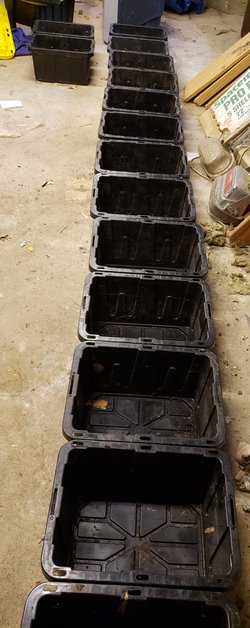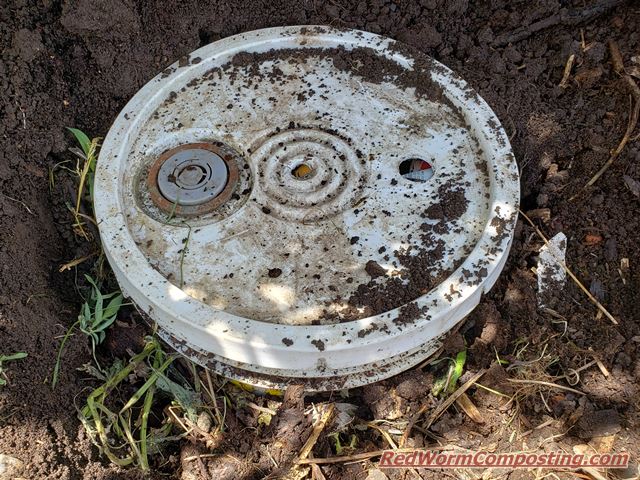Home Vermicomposting
Anything relating to (smaller-scale) worm composting at home!
Vermicomposting Clothing – Fall 2021 Update
Back in early December of 2020 I set up a system intended to test the use of biodegradable fabric as “bedding” material for vermicomposting. Most of the material came from ripped up cotton-based clothing, but I also added some old karate belts that happened to be lying around. To help get things rolling, I started things off with some compostable food scraps, and stocked the bin with worm-rich material from another active system.
The images below shows how things looked on the day I got things rolling.


This bin was set up at my dad’s place (where I have done most of my indoor vermicomposting for the past couple of years), and kept down (more…)
**For Even More Worm Fun, Sign Up for the RWC E-mail List!**Set-It-And-Forget-It Vermicomposting – 4 Month Update

Back in November I wrote about the set-up for a fleet of low-maintenance vermiculture bins (see “Set-It-And-Forget-It Vermicomposting“). It was just one of multiple sets of bins I set up last fall as a super simple way to move a lot of my worms indoors, keep them working away, while continuing to expand my “herd”!
When I called them “Set-It-And-Forget-It” I wasn’t kidding either! Other than a couple tweaks early on (come back to this in a minute), I did essentially forget about the bins until fairly recently.
What’s funny is this set of bins was actually one of the “younger” batches – only sitting for about 4 months! Some of the other sets have been sitting for more than 5 months (and counting).
Last week I decided to (more…)
Vermicomposting Clothing

A topic I have written amount multiple times here – but something I still really haven’t tested out enough – is the use of biodegradable fabrics as worm bin bedding materials.
It just seems like a bedding with so much potential! These fabrics are soft, very absorbent, yet also support excellent air flow. They tend to break down very slowly, helping to maintain a quality worm habitat for longer.
And while maybe not as readily available as something like cardboard, most of us likely end up with an accumulation of old clothes and sheets that aren’t fit for donation.
Finding a dusty bag of my old clothes at my dad’s place a week or two ago, I finally decided enough is enough. It’s time to really test this out properly!
Right off the bat I should point out that (more…)
Set-It-And-Forget-It Vermicomposting

When most people think of vermicomposting they tend to think of it as more of a continuous, active process.
This is all fine and good – and could even be considered one of the advantages of this approach – but I think more needs to be said about the power and potential of “batch” vermi-systems.
It a nutshell, the idea is that you add everything to the system right away – or at least early on – and then basically leave it alone, letting the worms and other organisms work their magic over time.
One example I have written about is Mark Payne’s “vernmenting” method, which even seems to offer the added advantage of letting you process some materials that wouldn’t be well suited for a typical worm bin.
I really love Mark’s approach with sealed (but still ventilated) buckets, but I personally prefer something a bit closer to a typical worm bin set-up.
The good news is that there isn’t just ONE “right” way to set up bins like this. The possibilities are endless, in fact. Even the bins within a group I set up at the same time can vary a fair bit.
That said…
There are still some key recommendations to keep in mind – and I will come back to these a bit further along. First, let’s look at how I recently (more…)
Backyard Vermifiltration Wrap-Up

Back in June I wrote about a DIY vermifiltration system I set up in my yard using an old leaky rain barrel.
The main idea was to collect greywater – dish rinsewater and cooking water likely the main sources – and to pour that through the system on a regular basis. As it percolated down it was worked on by countless microbes (assisted by the activity of Red Worms) and came out the bottom as a liquid far better suited for watering, and perhaps even helping to boost the fertility of nearby garden beds.
It was not a vermicomposting system in the traditional sense. Much of the starting material added early on was very resistant to breakdown – eg. expanded clay balls, woody materials, pine cones. This helped to maintain some structural integrity in the “filter” and created lots of surface area for microbial colonization.
That being said…
The system still provided me with an opportunity to (more…)
Basic In-Ground Bucket Worm Bin

As much as I love my “trench worm bins“, I realize a lot of people are looking for outdoor vermicomposting projects that are easier and to get up and running.
Even something like a buried plastic garbage can be pretty cumbersome, as I learned with my Vermi-Fertilization & Watering System.
The good news is that a bucket with some holes drilled in it is really all you need. Back in early June I decided to set one up to see how well it worked. I wanted to get it up and running as quickly as humanly possible – so I did cut some corners. (SPOILER ALERT: Everything has (more…)
Super Simple Homemade Manure

The topic of “homemade manure” is something I’ve written about quite a few times here on the blog (and elsewhere) over the years. I’ve grown to appreciate the concept even more in 2020, since it’s been even more important to be resourceful (especially early in the season).
I can’t even remember how long it’s been since I last had a source of farmyard manure, and our own supply of compostable kitchen scraps always become a precious commodity as the season progresses and my worm herds grow.
If you are new to “homemade manure” (HMM), the basic idea is that we are taking readily available (for the average homeowner) materials and creating a manure substitute that composting worms love.
Here is an equation that helps to explain: (more…)
